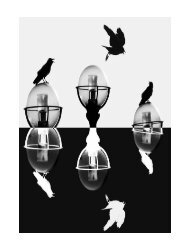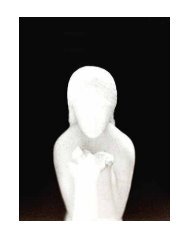Odds and Ends Essays, Blogs, Internet Discussions, Interviews and Miscellany
Collected essays, blogs, internet discussions, interviews and miscellany, from 2005 - 2020
Collected essays, blogs, internet discussions, interviews and miscellany, from 2005 - 2020
You also want an ePaper? Increase the reach of your titles
YUMPU automatically turns print PDFs into web optimized ePapers that Google loves.
medium for Newton’s laws of motion, his mechanical worldview. The fundamental goal of the
practitioners of linear perspective was the rendering of three-dimensional objects on a twodimensional
surface […]. An underlying premise in linear perspective is that light travels in straight
lines. This premise is combined with the premisses of Euclidean geometry to formulate rules for the
geometric construction of a perspective rendering of a scene as if observed through a window. […] This
method of rendering perspective, premised on the validity of Euclidian geometry, may properly be
termed “linear” […]. 15
Einstein’s criticisms of Euclidian geometry and further developments in the field of quantum mechanics helped
confirm the validity of the new artistic outlook. As Miller observed:
Advances in atomic physics, dependent on methods Einstein pioneered for theory building as well as on
his relativity theory, led to abstractions in visual imagery and a concomitant break with classical
causality. 16
He continues:
A hallmark of classicism in art and science is a visual imagery abstracted from phenomena and objects
we have experienced in the daily world. There is no such visual imagery in quantum mechanics or in
highly abstract art. Artists and scientist had to seek it anew rather than extrapolate it from the
everyday world. Just as it is pointless to stand in front of a Mondrian or Pollock, for instance, and ask
what the painting is of, so it’s pointless to ask what the electron under quantum mechanics looks like. 17
We can find echoes of this in Vargish and Mook’s Inside Modernism:
Cubism does not pretend to represent the single possible visual conception from a given perspective.
Instead each cubist painting proposes to engage the viewer in a specific conception of a contained
visual reality-in what Herbert Read called ‘a construct of the visual imagination’. A cubist work
presents itself not as the only valid representation of a given reality, but as one legitimate
representation of it. A cubist work of art does not say, ‘If you stood here where I specify at the moment
I dictate you would see exactly what you see represented in this picture’. Only Realism gets that
dogmatic. Instead the cubist work says, ‘I represent this plastic reality, this visual conception. My
representation is imaginative. It has a right, a right not to demand your passive agreement but to invite
your imaginative participation’. 18
The transmission of these artistic ideas into poetry was almost certainly due to Picasso’s close friend, the poet
Guillaume Apollinaire. Apollinaire, as Eduardo Kac says,
sought a Cubist approach to poetry. In certain poems he employed fragments of sounds and images
among words scattered on the page to convey the perception of a given scene or moment from a variety
of perspectives, paralleling the pictorial strategies of his friends Picasso and Braque. In other works he
created compositions of concise visual rhythm and rarified semantical density. 19
This practice also contributed to the narrative innovations that were being seen in modernist poetry. This is
articulated by Alan Soldofsky in ‘Bifurcated Narratives in the Poetry of Robinson Jeffers, C. K. Williams, and Denis
Johnson’:
In the context of the defining narratives of high modernism-Hart Crane’s The Bridge, T. S. Eliot’s The
Waste Land, Ezra Pound’s Cantos, and William Carlos Williams’s Paterson-poets experimented with
narrative structure […]. These experimental narratives tended to be disjointed and […] influenced by
cubism and other experimental forms of visual art, […]. In the case of Pound and Eliot, the deployment
of narrative fragmentation and disintegration works as an organizing strategy, a method of cubist
assemblage, particularly in The Cantos and The Waste Land, that compels the reader to construct an
emotional coherence out of the text’s manifold discontinuities. 20
This is particularly apparent in the first two lines of The Waste Land (‘April is the cruellest month, breeding / Lilacs
out of the dead land’), which combines the perspectives of Geoffrey Chaucer and Walt Whitman. As is well known,
33




